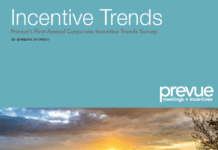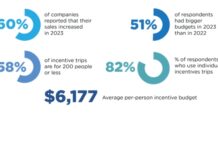
At the Incentive Research Foundation (IRF), we do research into many different areas around incentives and meetings.
Two of the places we have seen major interest in and opportunity over the last few years are the fields of behavior economics and neuroscience. As grand as these topics can seem, they can offer some great insight, not only into how we design programs, but why certain program design works. Below are a few findings that can help improve programs almost immediately.
Reward Presentation
Since the dawn of their creation, the inclusion of a gala awards show highlighting “the winners” has been a foregone conclusion for many organizations’ incentive travel programs. A recent IRF grant study by Flying Horse Communications, however, found that only some GenX men were highly engaged by a “Big Show,” such as a CEO delivering an award in front of the entire company. The remainder of these people were more drawn to a “little show” that involved their direct peer group and direct manager. Millennials and women were likewise, more likely to find a “little show” or peer to peer recognition more engaging.
While this doesn’t mean we must do away with award presentations altogether, it is an important reminder that these presentations should be balanced with smaller and more personal interaction. For example, instead of bringing everyone on stage, one company redesigned their final awards gala to have managers standing in the wings. On cue, the managers emerged from the sides and walked the awards directly to their recipient, who was seated at a table with their family and closest peers.
Temporal Bias & the Peak End Rule
Contrary to popular belief, the conscious, computational, language-loving new brain we all associate with “thinking” is not the first stop for most of our decision-making. This happens in the “old brain,” a highly active, multi-threaded area responsible for our “fight or flight response” that is significantly impacted by emotion. Our new brain often defers to our old brain to make decisions.
Ever drive to work on autopilot? This is your old brain at work, picking up the slack when your new brain is preoccupied with other things. This deferral means our old brain often biases our decision making. Humans have what is called “temporal bias,” which means we are more likely to remember short, peak emotional experiences more than longer, duller ones. It’s the reason you’ll remember your first one-second kiss forever, but have completely forgotten hundreds of hours of boring professor or peers’ presentations.
Even more, we tend to remember the last peak experience from an event most strongly and associate that emotion with the entire event. It’s why, even though you may have opened many great presents during Christmas as a kid, you will always remember a Christmas with disdain if the last gift you opened left you disappointed that is wasn’t that Red Ryder BB gun you were hoping for.
What does this mean to our events? It means that if we have money to put toward a peak experience, we should make sure that money goes near the end of an event, as it’s that last peak, emotional experience that people will remember. Ending on a strong, emotional high note ensures the event resonates for years to come.
Hyperbolic Discounting
Hyper-what? Although it’s a big word, it very simply means that we as humans tend to be biased toward receiving smaller payouts now versus much larger payouts later, even if those payouts are substantial. For incentive travel programs, this means if we wait until only the end to provide the payout, then we disengage a lot of our audience. “Fast start” and “early payout” options are good stopgaps, but can be expensive.
The good news is that status is also a reward. By providing immediate and on-going leaderboards showing who is in the lead, by giving recognition for the small wins along the way and by providing individual recognition for beating past targets during the program lifecycle, we can go a long way in keeping our audience engaged from the start through to the finish line.
There is still a great deal of research to be done in these fields and even more work to determine how findings like these translate into the world of incentive travel. But for now, these simple three findings are a great start on using behavioral economics and neuroscience to improve your next program.
For more information, check out these IRF studies:
How to Effectively Harness Behavioral Economics to Drive Employee Performance and Engagement
Translating the Neuroscience of Behavioral Economics into Employee Engagement










